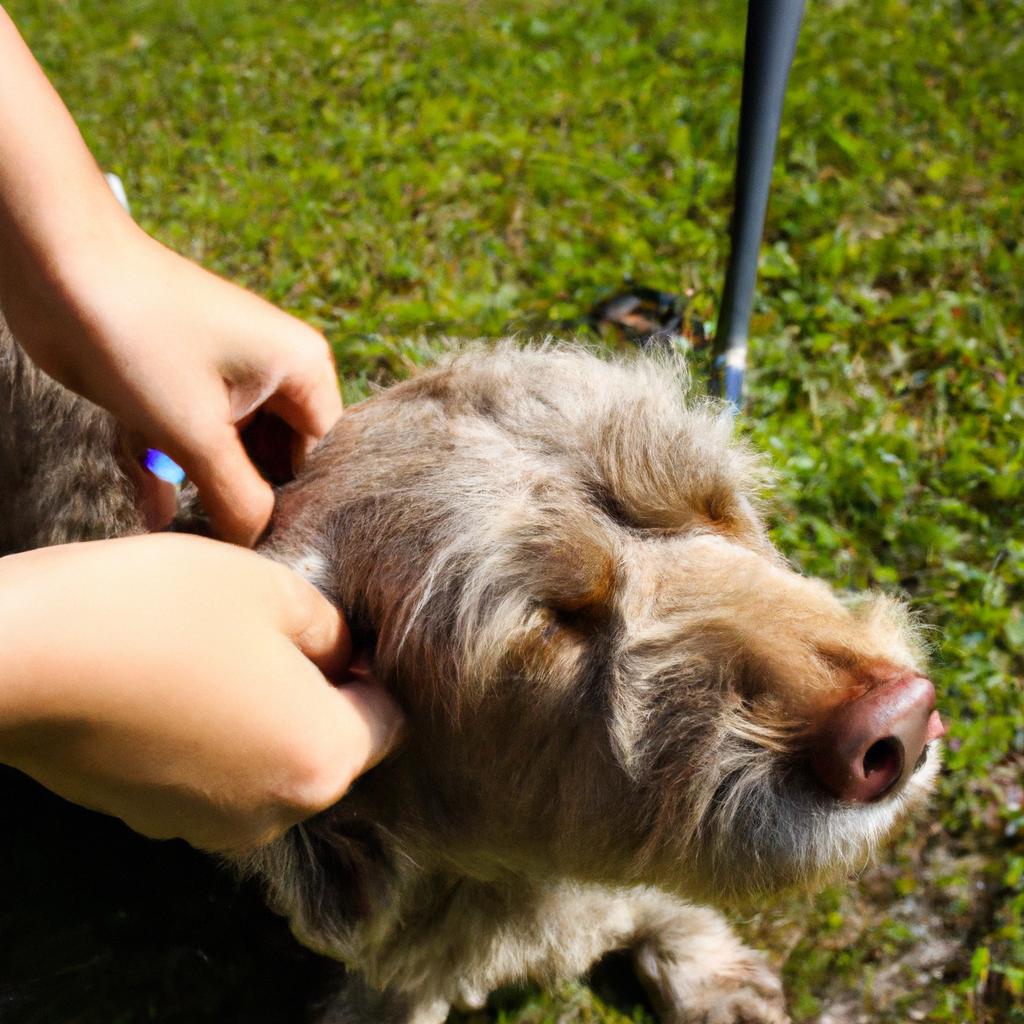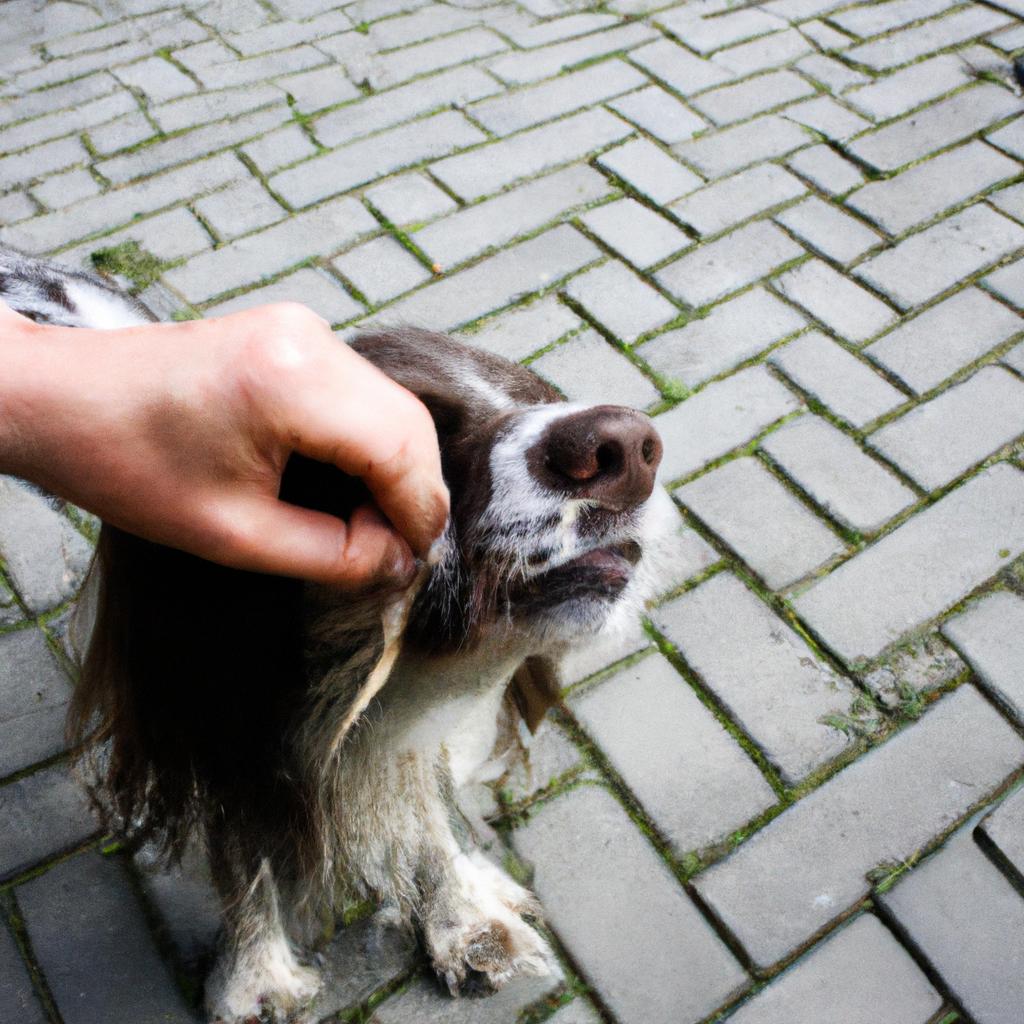Skin Conditions in Dog Grooming Salon: Ear Cleaning

Ear cleaning is a vital aspect of dog grooming that plays a significant role in maintaining the health and well-being of our furry companions. The presence of skin conditions in dog grooming salons, particularly pertaining to ear cleanliness, has emerged as a prevalent concern among pet owners and professionals alike. For instance, consider the case study of Max, a five-year-old Golden Retriever who frequently visited a local grooming salon for his regular ear cleanings. Over time, Max developed an irritating rash around his ears, causing discomfort and distress. This example highlights the importance of addressing skin conditions associated with ear cleaning in order to ensure optimal care for dogs during their grooming sessions.
In recent years, the occurrence of various skin conditions related to ear cleaning has raised concerns within the dog grooming industry. These conditions can range from minor irritations such as redness and itching to more severe issues like infections or inflammations. Identifying these skin conditions promptly is crucial not only for the comfort and overall well-being of dogs but also to prevent potential complications that may arise if left untreated. As such, it becomes imperative for groomers and pet owners alike to be knowledgeable about common skin conditions associated with ear cleaning procedures in order to minimize any negative effects on canine health.
This article aims to This article aims to provide an overview of common skin conditions associated with dog ear cleaning, including their causes, symptoms, and treatment options. By understanding these conditions, pet owners and groomers can take proactive measures to prevent them from occurring or address them promptly if they do arise.
Understanding common skin conditions in dogs
Skin conditions are a prevalent issue among dogs, often requiring regular attention and treatment. One example that illustrates the significance of these conditions is a case study involving a Golden Retriever named Max. Max frequently visits a dog grooming salon for his routine grooming sessions, including ear cleaning. However, due to neglecting proper ear hygiene over time, he developed an irritating condition known as otitis externa.
To gain a comprehensive understanding of common skin conditions in dogs, it is essential to recognize their various causes and symptoms. These conditions can arise from allergies, parasites, infections or hormonal imbalances. Allergies may trigger itching and redness on the skin, while external parasites such as fleas and ticks can cause severe irritation. Infections caused by bacteria or fungi manifest through hair loss and inflammation. Additionally, hormonal imbalances may lead to changes in the texture and appearance of the coat.
The impact of these skin conditions on both dogs and their owners cannot be underestimated. They often result in discomfort for the affected dogs, leading to excessive scratching or biting at their irritated areas. This incessant scratching not only exacerbates the problem but also puts them at risk of secondary infections due to open wounds. Furthermore, owners become concerned about their pet’s well-being as they witness their beloved companions suffer.
- Helplessness: Owners feeling helpless when witnessing their pets’ distress.
- Guilt: Dog owners experiencing guilt if they neglected preventive measures.
- Frustration: Dogs becoming frustrated due to constant discomfort.
- Anxiety: Pet parents worrying about potential long-term effects on their furry friends’ health.
In addition to recognizing the emotional toll inflicted upon both dogs and their owners, it is crucial to understand specific details regarding common skin conditions faced by our canine companions:
| Skin Condition | Causes | Symptoms | Treatment |
|---|---|---|---|
| Allergies | Environmental | Itching, redness | Antihistamines, steroids |
| Parasites | Fleas, ticks | Irritation, scratching | Topical treatments |
| Infections | Bacteria, fungi | Hair loss, inflammation | Antibiotics, antifungals |
| Hormonal issues | Imbalances | Coat changes | Medication or hormone therapy |
Understanding these common skin conditions in dogs not only helps us empathize with the challenges faced by both pets and their owners but also allows us to address them effectively. Consequently, it sets the stage for comprehending the importance of ear hygiene in dog grooming.
[Transition into the subsequent section about “The importance of ear hygiene in dog grooming.”]
The importance of ear hygiene in dog grooming
Understanding common skin conditions in dogs, particularly those that affect the ears, is crucial for dog groomers to ensure the health and well-being of their furry clients. One prevalent issue encountered in grooming salons is ear infections caused by various factors such as allergies, moisture buildup, or foreign objects. To provide optimal care for these beloved pets, groomers must prioritize ear hygiene through regular cleaning and prompt identification of any symptoms.
For instance, let’s consider a hypothetical case of a Labrador Retriever named Max who frequently visits a local grooming salon. Despite being a healthy dog overall, Max has been experiencing recurrent ear infections lately. This scenario highlights the importance of understanding how certain skin conditions manifest specifically within the ears.
To better comprehend the significance of proper ear hygiene in preventing and managing ear infections, it is essential to acknowledge some key points:
- Prevalence: Ear infections are one of the most commonly diagnosed ailments in dogs. They can occur due to multiple reasons but are often associated with underlying issues like excessive wax production or trapped moisture.
- Symptoms: Identifying an ear infection can be challenging since early signs may go unnoticed. However, typical indications include constant scratching or rubbing of the ears, head shaking, redness or swelling around the ears, unpleasant odor emanating from the ears, and discharge.
- Consequences: Neglecting proper ear hygiene not only exacerbates existing infections but also increases the risk of secondary complications such as hearing loss or damage to sensitive structures within the ear canal.
- Preventive measures: Regularly inspecting and cleaning dogs’ ears during grooming sessions helps prevent potential infections before they become problematic. By adhering to recommended practices for maintaining cleanliness and dryness in canine ears, groomers can significantly reduce the likelihood of developing these conditions.
| Consequence | Emotional Impact |
|---|---|
| Hearing loss | Potential decreased quality |
| of life for the dog | |
| Damage to ear | Pain and discomfort for |
| structures | the dog |
| Recurrent | Frustration and concern for |
| infections | pet owners |
In conclusion, understanding common skin conditions in dogs, particularly those affecting the ears, is crucial knowledge for groomers. By recognizing the prevalence, symptoms, consequences, and preventive measures related to ear infections, groomers can take proactive steps towards maintaining optimal ear hygiene. In the subsequent section about “Identifying symptoms of ear infections in dogs,” we will delve deeper into specific signs that help groomers detect these issues promptly.
Identifying symptoms of ear infections in dogs
Neglecting proper ear hygiene in dog grooming salons can have detrimental effects on dogs’ overall health and well-being. To illustrate this, let’s consider a hypothetical case study involving a Golden Retriever named Max. Max frequently visited his local grooming salon but did not receive regular ear cleanings. Over time, Max developed various skin conditions related to his neglected ears.
Firstly, due to the accumulation of dirt, debris, and excessive ear wax, Max experienced itching and discomfort in his ears. This led him to scratch excessively, causing further irritation and potential injury to the delicate ear tissues. The constant scratching also disrupted the natural balance of microorganisms in his ears, increasing the risk of infections.
Secondly, as a result of untreated infections caused by neglecting proper cleaning, Max suffered from inflammation and swelling in his ear canals. This condition is known as otitis externa and can be painful for dogs. The prolonged presence of infection-causing bacteria or fungi may even lead to more severe complications such as middle ear infections or hearing loss.
Thirdly, long-term exposure to moisture trapped inside uncleaned ears created a favorable environment for yeast and bacterial growth. As a consequence, Max developed an unpleasant odor emanating from his ears—a telltale sign of an underlying problem that needed attention.
- Increased stress levels for dogs due to chronic discomfort
- Emotional distress experienced by pet owners witnessing their beloved pets suffer
- Financial burden arising from repeated visits to veterinarians for treatment
- Potential deterioration of the human-animal bond if these issues persist unchecked
To grasp the gravity of these consequences further, refer to the table below highlighting specific implications associated with inadequate ear cleaning:
| Consequence | Description |
|---|---|
| Chronic itching | Persistent scratching due to discomfort caused by uncleaned ears |
| Inflammation | Swelling and redness in the ear canals from untreated infections |
| Malodor | Unpleasant smell emanating from infected or dirty ears |
| Hearing impairment | Potential loss of hearing ability resulting from severe infections |
Understanding these potential consequences emphasizes the crucial significance of proper ear cleaning practices. Now, let us explore effective techniques for maintaining optimal ear hygiene in dogs without delay.
Proper techniques for cleaning dog ears
Having identified the symptoms of ear infections in dogs, it is essential to understand the proper techniques involved in cleaning a dog’s ears. By following these methods diligently, groomers can help maintain their canine clients’ ear health and prevent future complications.
Example Case Study:
To illustrate the importance of proper ear cleaning techniques, consider a hypothetical scenario where a grooming salon neglects appropriate procedures. A dog named Max visits this salon regularly but starts showing signs of discomfort and scratching his ears excessively after each visit. Upon closer examination, it becomes evident that improper ear cleaning practices have led to an untreated ear infection in Max. This unfortunate situation could have been avoided with the correct application of safe and effective techniques for cleaning dog ears.
Proper Techniques for Cleaning Dog Ears:
- Preparation:
Before starting the actual cleaning process, gather all necessary materials such as cotton balls or pads, sterile saline solution or veterinary-approved ear cleaners, and gloves if desired. - Gently Removing Debris:
Using a gentle touch, carefully remove visible debris from the outer part of the dog’s ear canal using your fingers or tweezers designed specifically for this purpose. Avoid inserting anything deep into the canal to prevent injury. - Applying Ear Cleaner:
Moisten a clean cotton ball or pad with an appropriate veterinary-approved cleaner or sterile saline solution. Gently wipe the visible parts of the inner ear flap and accessible areas inside the dog’s ear canal. - Drying:
Allow any excess moisture to evaporate naturally or use a soft cloth to gently dry around the exterior area of the cleaned ears.
Common challenges encountered during dog ear cleaning
- Excessive hair growth in the ear canal hindering visibility and access
- Dogs being resistant due to previous painful experiences
- Lack of knowledge about proper techniques leading to ineffective cleaning
- Failure to identify underlying conditions requiring professional attention
| Common Challenges | Effects on Dog’s Ear Health |
|---|---|
| Excessive hair growth in the ear canal hindering visibility and access | Increased risk of trapped moisture, infections, and wax buildup |
| Dogs being resistant due to previous painful experiences | Difficulty in performing a thorough cleaning leading to incomplete removal of debris |
| Lack of knowledge about proper techniques leading to ineffective cleaning | Potential for unintentional harm or irritation to the dog’s ears |
| Failure to identify underlying conditions requiring professional attention | Delayed treatment resulting in worsening symptoms and potential complications |
By following these proper techniques for cleaning dog ears, groomers can ensure that their canine clients receive optimal care. These methods help minimize discomfort, prevent infections, and maintain good ear health. However, it is important to remember that each dog is unique, so tailoring the approach based on individual needs is crucial.
Transition Sentence into Subsequent Section:
Understanding how to properly clean dogs’ ears lays a solid foundation for preventing ear problems in grooming salons. By incorporating preventive measures into daily routines, groomers can further safeguard the well-being of their furry friends.
Preventing ear problems in the grooming salon
Having discussed proper techniques for cleaning dog ears, it is equally important to focus on preventing ear problems in the grooming salon. By implementing certain measures and practices, groomers can significantly reduce the risk of skin conditions related to ear hygiene.
To illustrate this point, consider a hypothetical scenario where a dog named Max visits a grooming salon regularly but starts experiencing recurring ear infections. Despite regular ear cleanings, Max’s condition worsens over time due to various factors that could have been prevented with proper preventive measures.
To effectively prevent ear problems in the grooming salon, here are some key considerations:
- Maintain cleanliness and sanitation:
- Regularly disinfect all tools used during ear cleaning procedures.
- Ensure that surfaces, including tables and workstations, are sanitized between each client.
- Use disposable gloves when handling dogs’ ears to avoid cross-contamination.
- Implement strict protocols for maintaining overall cleanliness within the salon premises.
By following these preventative measures, groomers can create a safe environment that minimizes the risk of potential ear issues. However, it is also essential to be aware of breed-specific vulnerabilities and take additional precautions accordingly. Certain breeds prone to chronic ear infections may require extra attention or specialized care during their grooming sessions.
In summary, prevention is crucial when it comes to addressing skin conditions related to ear hygiene in the grooming salon. Maintaining cleanliness and adhering to specific protocols can go a long way in reducing the likelihood of such problems occurring.
Transition into subsequent section about “Tips for maintaining healthy ears in dogs”: With these preventive measures established, let’s now delve into effective ways for maintaining healthy ears in dogs without causing any discomfort or harm.
Tips for maintaining healthy ears in dogs
Example Scenario:
Meet Max, a five-year-old Golden Retriever who visits his local grooming salon regularly. Despite being well-cared for by his owner at home, Max has recently developed recurring ear infections after each visit to the salon. This serves as a reminder that diligent measures need to be taken when it comes to cleaning and caring for a dog’s ears.
Tips for maintaining healthy ears in dogs:
-
Regular inspection: Before starting any grooming session, perform a thorough examination of your canine client’s ears. Look out for signs of redness, swelling, discharge, foul odor or excessive wax buildup. Identifying potential issues beforehand will allow you to take appropriate action promptly.
-
Gentle cleansing routine: When cleaning a dog’s ears during grooming sessions, remember these key points:
- Use only veterinarian-approved solutions specifically designed for canine use.
- Avoid using cotton swabs or other sharp objects inside the ear canal as they may cause injury.
- Gently wipe away visible dirt and debris from the outer part of the ear and around the opening.
- Limit deep cleaning to what is necessary and always follow professional guidelines.
-
Promote airflow and drying: After bathing or swimming activities, ensure adequate airflow within the dog’s ears by gently wiping them dry with an absorbent cloth. Moisture trapped inside can create an ideal environment for bacteria and yeast growth.
-
Seek veterinary assistance when needed: If you notice persistent symptoms such as itching, discharge, or a foul smell coming from the dog’s ears despite regular cleaning efforts, do not hesitate to recommend that the owner seek professional veterinary care. Timely intervention can prevent minor issues from developing into more severe conditions.
- Protect your furry friend: Proper ear care is crucial for safeguarding your dog’s well-being.
- Prevent discomfort and pain: Neglecting ear health can result in painful infections and chronic conditions.
- Enhance the bond with your pet: By maintaining healthy ears, you contribute to their overall happiness and quality of life.
- Ensure peace of mind: Regular ear maintenance helps minimize the risk of costly veterinary treatments down the line.
| Common Ear Problems | Symptoms | Causes | Treatment |
|---|---|---|---|
| Otitis externa | Itching, redness | Allergies, excessive moisture | Medication, ear drops |
| Ear mites | Excessive scratching | Contagious infestation | Veterinary-prescribed medication |
| Hematomas | Swelling, blood-filled lump | Trauma or injury | Surgical drainage |
| Polyps | Impaired hearing | Abnormal tissue growth | Surgical removal |
In summary,
Maintaining healthy ears in dogs requires diligence during grooming sessions. Conduct thorough inspections before starting any procedure and use gentle cleansing techniques with veterinarian-approved solutions. Encourage proper airflow and drying after water-related activities while being vigilant for persistent symptoms that may require professional attention. By following these tips consistently, you can help keep your canine clients free from uncomfortable skin conditions arising from neglectful ear care practices.




